The guys at FirstSpear have been hard at work in their design shop cooking up some pretty amazing leaps forward in tactical nylon. The newest additions to their line include two distinct yet complimentary improvements; 6/12 and Tubes.
6/12
Developed over the last year, 6/12 is the answer to the question tactical nylon makers have been asking for more a decade. How can I outdo PALS? What they came up with is really pretty simple but involves advanced materials science. The key is the platform which combines adhesive heat-set backing and laser cut precision attachment points. Say goodbye to weaving, and better yet, no more pulled through snaps. You fold the 6/12 tab in half, slide it through the slot and flatten the tab out on the inside of the platform. The hook and loop hod the pouch fast.
You want to continue to use your current MOLLE pockets? No problem, the spacing interval is the same as PALS so 6/12 accommodates those as well.
FirstSpear can apply the 6/12 technology to any platform including armor carriers, chest rigs, drop leg panels, etc. The result is a smoother profile, cleaner appearance and lower weight.
Some who have seen 6/12 have voiced concerns that it won’t hold as solidly as PALS. While that remains to be seen, one thing seems evident. If the Velcro-based 6/12 system does give, the pouch will remain intact and bartacks won’t be pulled apart. There are other advantages over traditional PALS as well. Since there is no externally bartacked nylon webbing, there is less weight overall. In fact, when you factor in the extra weight of the PALS attachment system on pouches (webbing, polymer, snaps) along with the PALS webbing on the platform itself, 6/12 offers a 20%-40% reduction in weight. Finally, there is less labor to bartack the webbing in the first place. Additionally, the platform is more streamlined with less to hang up on.
Tubes
Tubes is the other half of the equation and represents true innovation. No more Velcro…No more cables…No more components spread around the ground.
Currently, most armor carriers feature a hook and loop flap closure to join the two sides of the cummerbund in the front. Not only can this flap arrangement be a pain to properly align and close, it adds bulk, weight, and noise. Additionally, the hook and loop can wear out quickly and is prone to retaining water, mud, and snow. From a protection standpoint the hook and loop closure flap allows for misalignment of the cummerbund resulting in improperly placed side plates and inflatable floatation. As you can see in these photos, Tubes alleviates the need for a front closure flap as well as those pesky alignment issues.
Additionally, while cable release systems are all the rage, they can be misrouted, difficult to reassemble quickly, and heavy. Worse yet, when incorrectly configured, tug as much as you like, they won’t work.
Tubes is the perfect name for the technology as it is composed of a rod that fits inside a tube which serves as a container, holding it in fast. Pull out and up or down and the rod slides free from the tube and the closure is open. Additionally, Tubes is molded from high strength GhillieTEX material provided by ITW Military Products. This is a IR signal reduction technology which enhances the overall signature management of the wearer.
Granted, Tubes does require either more than one hand or, more than one movement to use, but the movements required to ditch the vest are exactly the same movements required to administratively don and doff the carrier. The user builds muscle memory every time he puts on or removes his armor.
This video from FirstSpear should give you a good idea of how the two technologies work.
I’ve only seen these technologies in person once, but the 6/12 effect is real. I am duly impressed with the fusion of materials and design which turns what we think about both pouch attachment and cutaway systems, on its head.
See the entire FirstSpear line at the Elite Defense booth #27411.
Tags: FirstSpear, GhillieTex, SHOT Show


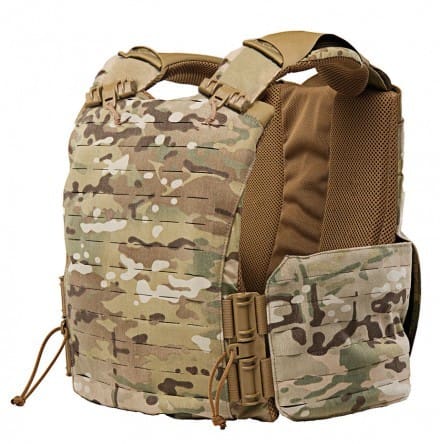
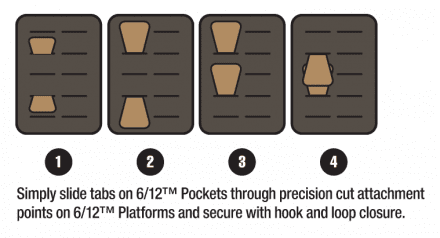
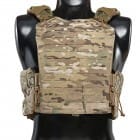
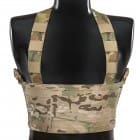
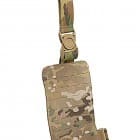
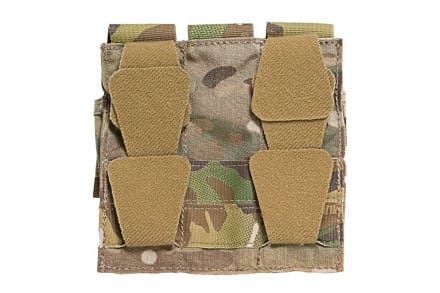
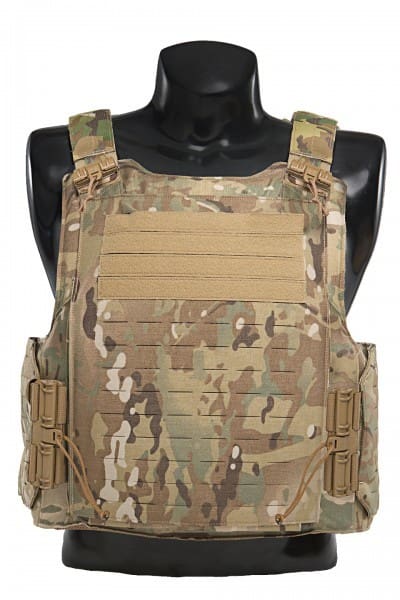

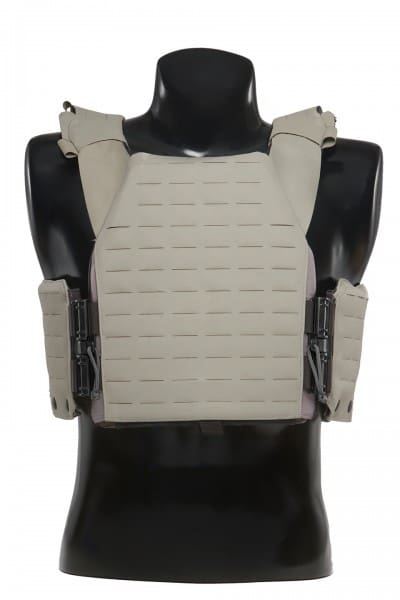
Very interesting, but I think I’ve seen something similiar to the 6/12 before in the backpacking industry and in that not-so-sucessfull Blackwater Gear. There were complete laminated panels with laser cut out holes for interweaving the molle vertical straps. It was used mostly in pockets they offered back then. I just wish to see how you mount a whole set of the pouches on that plate carrier without taking out the plates and backers – for the fastening method looks nice when done in a loose sheet of a laminate, bugs me how it would do on a complete carrier, modular belt or a leg panel. With classic MOLLE stuff it may be little painful to thread the strap with protruding snap stud through all these holes when on a vest. I wish they would do some more videos though, where they would show how it works in the cases mentioned above because weight saving effect is appealing.
I wonder if FS will eventually license these two solutions for the other parties or try to keep them for themselves?
Good points. I’ve seen it used on vests. Yes, you have to open the carrier to affix the tabs. However, there’s no need to remove the armor insert. It’s easy to use.
I believe, for both of these technologies to be truly successful, FS must license them to others. Tubes is a natural.
Pouches on velcro ? No, thanks.
That’s a bit of a simplification don’t you think? Take a look at how they attach. This isn’t the old 1980s, “throw a big square of Velcro on the fron of your vest” deal. 6/12 weighs less than PALS because it eliminates webbing, plastic and snaps. It also is held fast on the back face of the platform and the platform itself aids in retention.
My big question is with the shoulder tubes…how uncomfortable would they be with a heavy ruck riding across them. They seem like with a lot of pressure on the shoulders that they might be uncomfortable.
I don’t think it will be an issue due to their size and location, but its a good question. Hopefully, we will get some feedback on this soon.
Looking at them in some of the imagery there seems to be a far amount of rise off the actual plate carrier on the shoulders. I’d be worried about the pressure pointing, and shoulder straps potentially getting caught on them as well.
Very similar to Asgaard Tactical lightweight plate carrier.
https://fbcdn-sphotos-a.akamaihd.net/hphotos-ak-ash4/385030_251749341562313_226343097436271_580543_1829416304_n.jpg
No, the Asgaard carrier sorta looks like the FS technology, but you can see that it isn’t alike at all. They have been working on this for a year and have developed an entire attachment system around it. Asgaard just posted pics within the last week. FS uses a laminate base fabric which adds stability and strength, Asgaard uses 330 and 500D. The Cordura by itself will rip out. I can tell this is new to him in other ways as well. He has some issues with his cutouts that will manifest with use.
The cutout in the rear looks like P2SYS to me.
Asgaard gets an “E” for effort but he doesn’t have access to the secret sauce on this one. I look forward to seeing more of his designs. Plus, how can you not love the name?
With similar I was referring to the laser cut system, and the compatibility with MOLLE pouches. Of course First Spear have this in development for some time -a year, as you say in the comment-, and they have an innovating design that I hope to have hands on as soon as possible
The Asgaard guy explained the limits of the materials he used, so it is obvious for him that Cordura isn’t the best material for this type of work.
And about the name, saturation of Nordic mythology in the last months, hahaha.
Well technically anyone with a laser table cutter could do this I guess. FS thing looks like laminated Cordura 500D and velour Velcro backing to faciliate attaching of these small two-sided velcro fishtails and prevent tearing.
Who makes this Asgaard Plate Carrier btw?
Asgaard Tactical, look for him on FB.
Found it, thanks! His work resembles much more what S&S did with their Plate Frame.
As mentioned in the first post, the 6/12 concept was tried some time ago and it didn’t work out too well in the long term use tests. Sagging and tearing of the base layer became an issue as the materials wore. It will be interesting to see how the fabrics FS uses stand up to a long term and harsh use test.
The tubes idea raises a lot of questions. Cold weather durability of the plastics? A way to prevent inadvertent releases? It would suck to have one come undone in freefall or as you’re getting out of a platform because it got snagged on something. Pressure points and digging into the user is a biggie. The other issue is breakage. What happens if one of those tubes gets broken some how, what then? Murphy is a MOFO and if it can be broke, it will get broken by someone no matter how Ranger proof you make it.
You’ve made just about every argument made against every load carrying or armor system out there.
This isn’t early versions of die cutouts. There’s a lot more going on.
As for Tubes, it’s made from GhillieTEX material. The question you have to ask yourself is, do you trust them? If the answer is “no” then I have to ask you what your gear is made from.
To address the “free fall” issue. Very few vests are ever built with MFF from the outset because there are so few MFF parachutists and it is just a means of infiltration and not the op. If cutaways are an issue, many teams will place the armor in a bag and jump it that way.
Interestingly, the earliest cable release system were influenced by parachuting with the cutaway pillow and cable. Great care had to be taken if a vest was worn on MFF ops that the parachutist didn’t grab the wrong pillow.
It’s not a question of trusting something made out of GhillieTEX, it’s about the actual item itself and the way it functions/operates. It appears to have a propensity to release when the user might not want it to and or snag. Perhaps a better method of protecting the mechanism and or a cover will evolve into the design.
Tim D’annunzio , then owner of Paraclete, developed the first cutaway system for body armor and you are correct, it is based on the mechanics found on a freefall parachute cut away system. Of all the body armor systems out there that offer a cutaway system, only 1 to date has come undone in freefall and it was also prone to coming undone on the ground when loaded down if you picked it up by the shoulders wrong. As far as I know, that carrier isn’t being made anymore.
A carrier doesn’t have to be built with MFF in mind from the onset, it just has to work and not come undone so easily that it presents a hazard. Have you ever placed your body armor in a PDB and lowered it to land? What do they always tell you about your plates and dropping them? Jumping with body armor on and not in the PDB is becoming the norm for several reasons, you only have so much space in a PDB for things like a ruck and all the other gear you need on the ground, body armor takes up a good portion of a PDB when it’s loaded for bear. Grabbing the wrong pillow has never been an issue, you have one red cutaway pillow on a military parachute and it not located in a position where body armor carriers typically have theirs. The main and reserve handles are metal so the chances of confusing them with a pillow is quite low.
I think FS has something pretty trick going on with the two new features but the realist in me isn’t too quick to drink the kool-aid just yet, time will tell if the two ideas prove practical in their current configurations or not.
I wanted to chime in here in response to what has been said regarding my design and its similarity to FS. I’ve had these thoughts grinding in my head for a while and it basicly bottles down to an impulse, saturday morning experiment in seeing how basic, stripped down and light weight I could make a carrier.
I dont want to compare the rough 6 hours I put in to my platecarrier with the year of development that First Spear put in to it. The two systems are completely different, and developed with different purposes in mind and for different reasons.
Thanks for weighing in Sebastian. It is very professional of you. Your stuff looks good and we hope to see more of it.
Excellent concept.
Personally would like to see this also happen on other load carriers like packs. Low profile, non-molle but still with the capability to attach pouches.
When this guy attac clips to the molle-like slot platform, he dont use actual vest, he uses pieces of fabric, so it is very easy to snap velcro on inside surface of platform. But what about real platform? You will have to pull two pieces of thin velcro inside a flat volume between the slots, and try to connect them, so they connect to each other with maximum size of surface. At the same time you have to put fingers between velcro parts so it dont connect too early. I mean with actual vest, pouch attachment will be harder than for example using the classic stiff clips (MALICE, webbing stiched with plastic etc.)…
RIF
I’m interested to see more details about the Tubes system. The release mechanism reminds me of the Dragon Clip on Emdom’s CM belt. I like the innovative features of both. I hope FS can chime in with further details. It looks like a great leap forward in armor design.
The 6/12 system looks too complicated. The mounting doesn’t look secure in my books. If this plate carrier concept takes off I see more users sticking to their old pouches and strapping them on this thing. I’d also be curious of the strength of the lamination. I’ve seen product videos where bartacked MOLLE can take at least 200+ lbs before ripping. Not that you need that much strength but it is a plus in gear design. In any case kudos to FS for making new innovative designs for gear design.
The pic showing the back side of the cummerbund and the tubes has a section of webbing and beads. is that for drop attachments? or attaching to a belt..
That is a flotation system. Look for more info soon.
Flotation insert in the cummerbund side. Forgot who makes them, but they work with FS.
PECI
Mustang are the flotation guys… And nice gear they make too…
I have to say I think fs have done a great job on this design, I hope they use a laminate like tyr do with the Kevlar 20 for their PV to ensure no tearing,
I don’t agree with the Velcro closure issues in the article and tubes seems to allow a loss of real estate in two good areas for load carriage. I think these vest will be at their best used with molle and the option to mount it in 1″ height increments makes it more flexible than PALS from the outset. Not having seen it yet, I figure the next big closure will be the itw/as trial collaboration !!! But tubes I’m sure has a bright future!
An alliance between FirstSpear and Tyr Tactical, with their famous PV hybrid textile, would make this an absolute rock solid and awesome solution.
As it is, I’m a bit concerned about the the wear and tear that will occur on the 6/12 cuts with heavy MOLLE pouches attached to it, pulled, and everything nasty that can happen with protruding pouches.
Tubes look interesting, but some feedback is needed regarding its breaking point.
Looks like the 6/12 is indeed a laminate. Far as how it compares to PV, might be, uh, 6 of 1, half-dozen of the other.
On a side note: Regarding the QR systems development – while mr. D’Annunzio surely holds one of the patents (dated 2003 or 04 IIRC) for such system, he’s by no way first to apply it for ballistic vests. While ago I did a research suggesting that first development was made by British in their 1942 aircrew anti-flak armor, later adopted by USAF as M1 Flyers Armor Vest and further developed.
My first concern about the Tubes are these cute paracord loops snagging on things and accidentally opening the whole business.